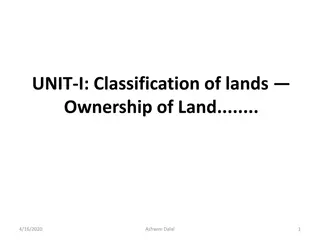Understanding Biosystematics and Its Significance in Biological Classification
Biosystematics plays a crucial role in refining biological classification by focusing on biological criteria to define relationships within closely related species. It helps delineate biotic communities, recognize different biosystematic categories, and understand evolutionary patterns. Through the integration of genetic, ecological, and experimental criteria, biosystematics provides valuable data on variation within species, aiding in resolving classification and evolutionary issues. Traditional methods involve controlled hybridization and experimental studies in common gardens.
Download Presentation

Please find below an Image/Link to download the presentation.
The content on the website is provided AS IS for your information and personal use only. It may not be sold, licensed, or shared on other websites without obtaining consent from the author. Download presentation by click this link. If you encounter any issues during the download, it is possible that the publisher has removed the file from their server.
E N D
Presentation Transcript
Biosystematics and its Importance The term referred to the use of biological criteriain refining classification Camp and Gily 1943, coined the term biosystematics . Mostly applied in studies of young lineages (that is, within and among closely related species). the system of
APPLICATIONS To delimit the naturally occurring biotic community of plant species. To recognize the various groups as separate biosystematic categories such as ecotypes, ecospecies and companion.
GOAL To organismal fundamental biological level and with an evolutionary perspective using experimental criteria. understand patterns of a variation at
Numerous thus number of data of all the characters of the individual or a species. This helps to clear problems concerning those plants that differ in their interrelationship, classification, and evolution. disciplines provide of science an innumerable
https://4.bp.blogspot.com/-WoP0PPHTj2c/WHMq58FhRQI/AAAAAAAAC8A/C1c3Q1WmndsL0auC4roDdES0O76b-FSNACLcB/s1600/biosystematics.gifhttps://4.bp.blogspot.com/-WoP0PPHTj2c/WHMq58FhRQI/AAAAAAAAC8A/C1c3Q1WmndsL0auC4roDdES0O76b-FSNACLcB/s1600/biosystematics.gif
MOTIVATIONAL REASON Taxonomy in early 1900s was in trouble. a lack of understanding about the causes of variation in nature led some prominent taxonomists to excessive "splitting . Rediscovery of Mendel's (19th Century) work on genetics in early 1900s and subsequent reconciliation of genetic principles and Darwinian evolutionary thought .
Variations in a species may be due to several factors such as physiological, population dynamic study and many other factors. provided by the biosystematist are taken for analysis and considered by the classical taxonomist in order controversial problems that may arise during their phylogenetic on their evolution of species under study. genetic, ecological, All the evidence to arrive at any classification based
METHODOLOGY Traditionally, biosystematic methods were mostly based on controlled hybridization and common garden or reciprocal transplant approaches. Biosystematic "experimental," as opposed to descriptive, often involving manipulation situation. Basically three important approaches: methods are of natural
1. It involves thorough sampling analysis of the taxonomic species under study. Its population, cultivation, geographical range, cytology, anatomy, phytochemistry, chromosomal and behavior are keenly observed and studied for finding any genetic differences that may arise populations. palynology, number, among different
2. It includes determination of the ability of different populations to interbreed among one another to form a variant species with its vigor and fertility. This will reveal the presence or absence barriers between taxa at various levels. 3. It involves the study of similarity of chromosomes in the meiosis. of breeding hybrids during
GENECOLOGY Genecology is a branch of ecology which studies genetic variation of species and communities compared population distribution in a particular environment. to their
ECOPHENE The variety of phenotypes (visible physical characteristics or behaviours), from a single genotype (a specific combinations of alleles in a gene), that can be observed in a population within a particular habitat.
ECOTYPE In evolutionary sometimes called ecospecies, describes a genetically distinct variety, population or race within a species, which is genotypically adapted to specific environmental conditions. Typically, though ecotypes exhibit phenotypic differences (such as in morphology or physiology) stemming from environmental heterogeneity, they are capable of interbreeding geographically adjacent ecotypes without loss of fertility or vigor. ecology an ecotype, geographic with other
COENOSPECIES coenospecies Either of a group of related species that are able to form (often fertile) hybrids quotations. (plural coenospecies),
COMPARIUM a group of organisms capable of direct or indirect interbreeding whether or not fertile hybrids result and being usually equivalent in scope to a taxonomic genus

















































